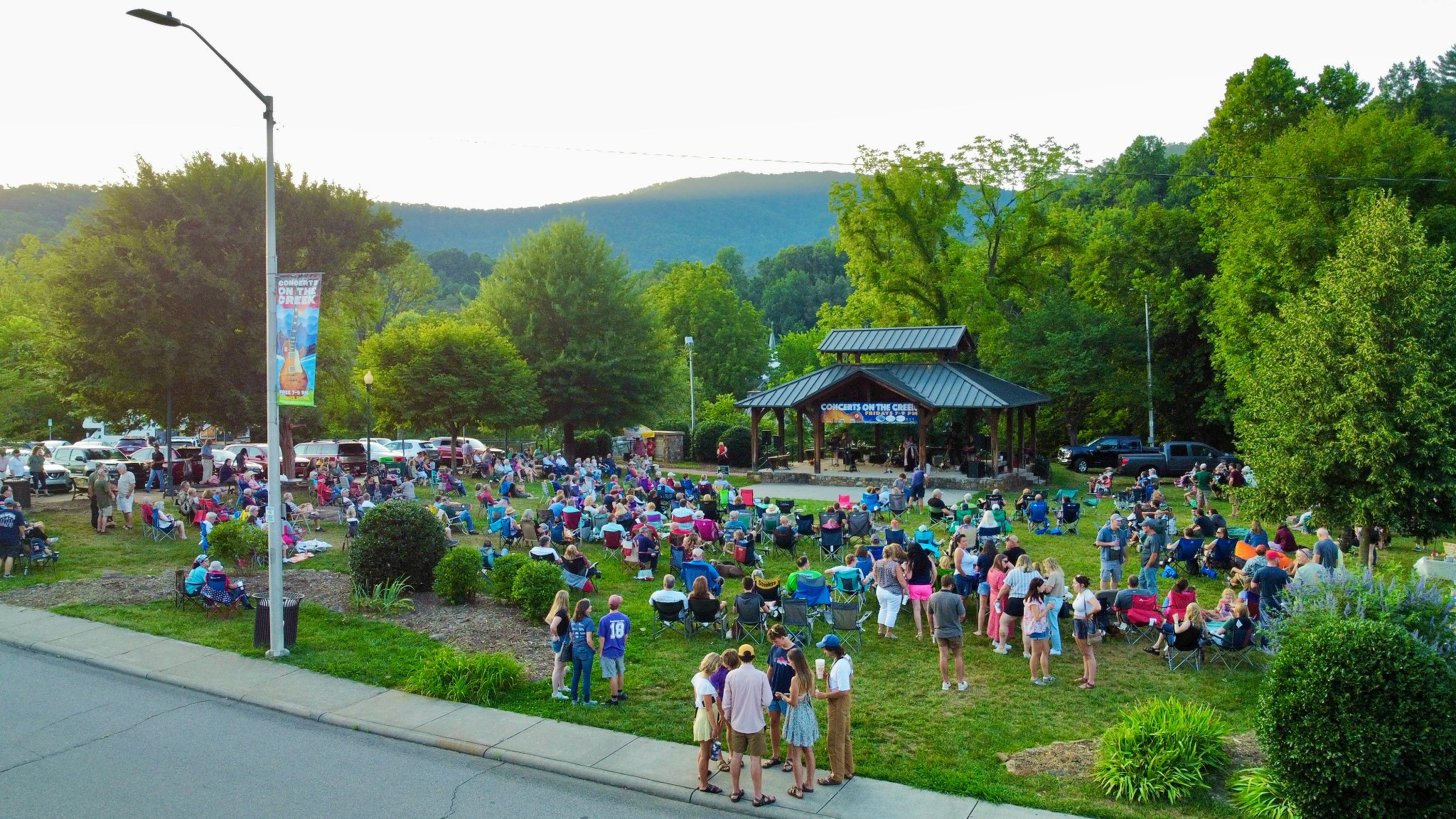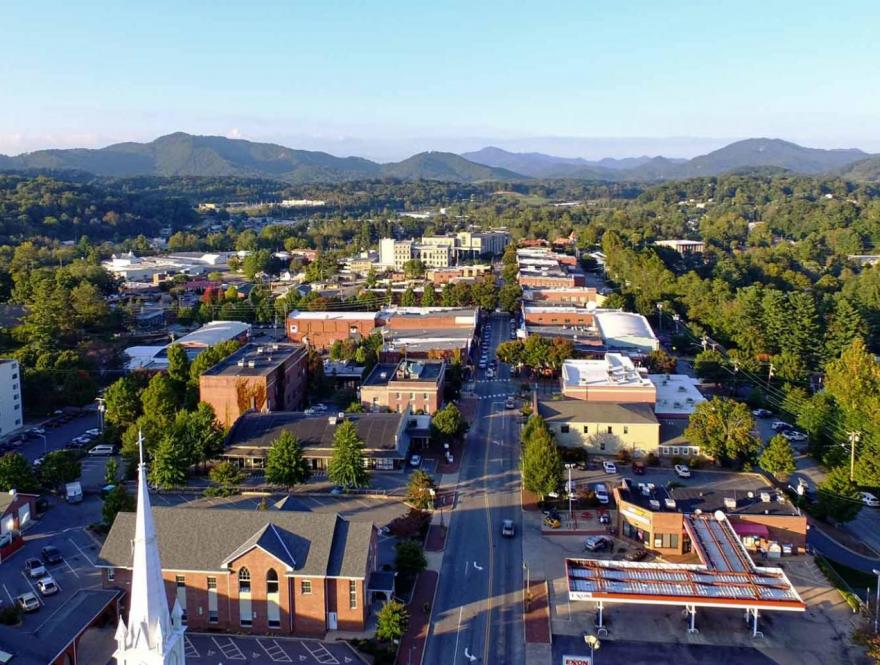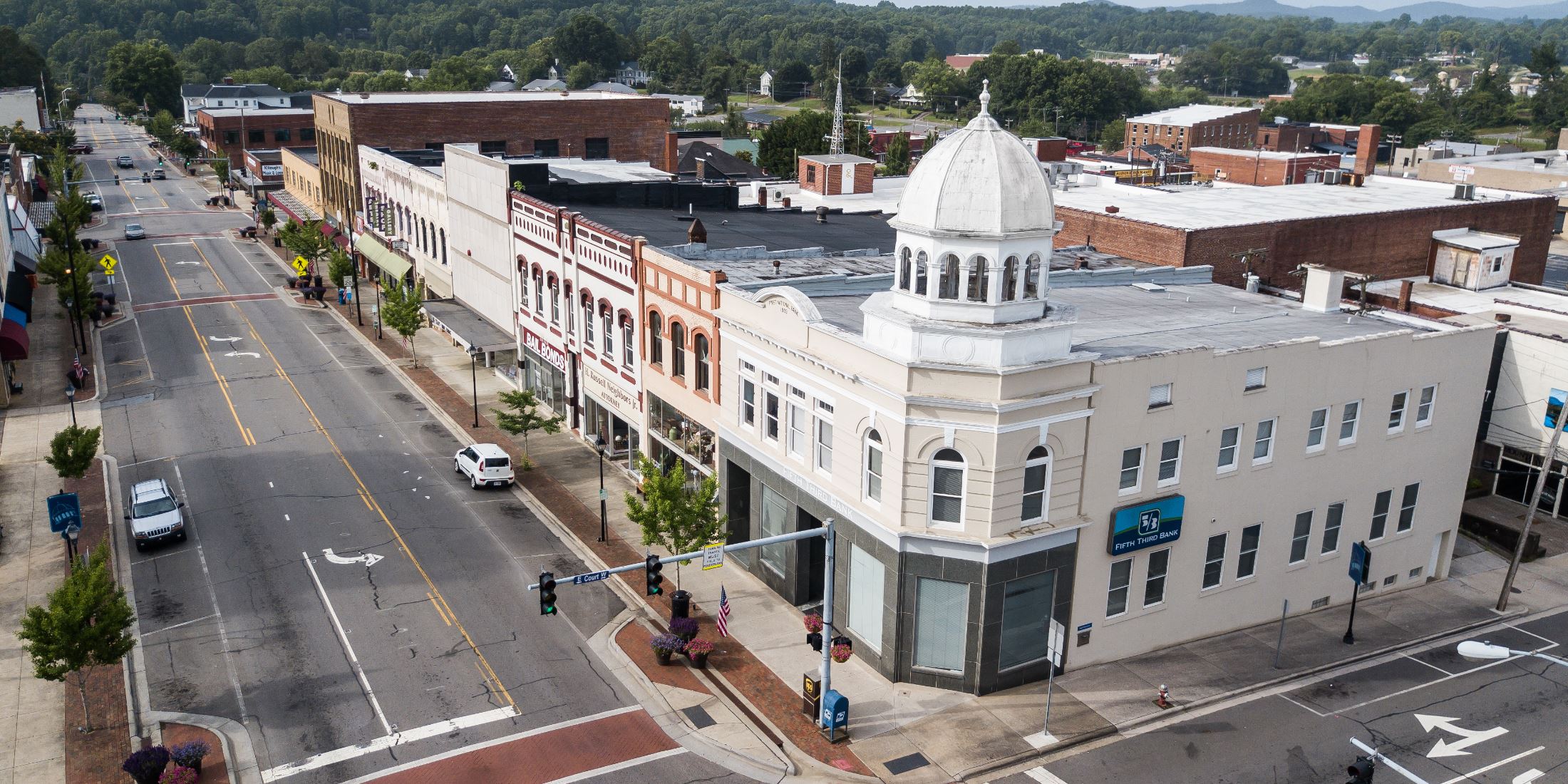The American Rescue Plan offers a generational opportunity for our municipalities, not just to recover from the pandemic, but to thrive well into the future. It is this forward-looking aspect of the ARP that is most consequential. How best can we utilize this money to create a lasting impact?
All across North Carolina, cities and towns are developing plans and programs specifically geared towards this question, and history shows us that these projects will be successful. When our municipalities receive financial support, they achieve substantial successes. Cities get the job done.
This ongoing series will showcase those projects, plans, and transformational investments, both to highlight the end-to-end impressive work of our municipalities and to share best practices with other cities and towns.
 Sylva Getting a Lot Out of a Little
Sylva Getting a Lot Out of a Little
Sylva, NC
Population: 2,696
Funds Received: $872,000
Plan
- Bridge Park beautification and stormwater improvements
- Pandemic related investments, including upgraded building ventilation, new audio-visual capabilities, and outdoor recreation
Strategy
Like many towns in western North Carolina, Sylva regularly plays host to far more than just its 3,000 permanent residents. As much becomes clear the moment you step foot downtown among the bustling shops, breweries, and restaurants all nestled beneath the sight of the mountains and historic hilltop Jackson County Courthouse. For American Rescue Plan purposes, however, it’s only the full-time residents that count for funding totals, leaving Sylva with a relatively small appropriation to serve a quickly growing community.
They succeeded in that goal through a single major project: Bridge Park, one of the town’s most well-used public spaces, regularly hosting gatherings, events, weekend concerts, food trucks, and more.
“It gives us another feather in our cap to attract visitors, but it’s a plus for our residents,” said Mayor and NCLM Board Member Lynda Sossamon. “It makes them feel proud of our downtown.”
The project is two-fold, strategically addressing both the improvement of a community asset and the needed investment into local infrastructure.
First, in regards to the community asset, the Bridge Park project will address a largely unused gravel lot that lies adjacent to the park. Sylva bought the property in 2014. This project will renovate that area to double the parking availability, create greenspace, introduce landscaping, add a walkway, and construct a pier over Scotts Creek, which runs through downtown. It will be a total makeover of Sylva’s flagship park.
Second, and perhaps more importantly, the impacts of the renovation will go far beyond just the surface-level appearance of the park. It will also address critical stormwater concerns for downtown.
In 2016, Sylva received a grant from North Carolina’s Clean Water State Revolving Fund to study Scotts Creek. Sylva used those funds to hire an engineering firm, which evaluated the area and drew up the plans Sylva is now pursuing. The park serves as a central tool in Sylva’s stormwater approach. By building the bio-retention pond, creating greenspace, and completing all other elements of the plan, Sylva isn’t just making the area more attractive—it’s also increasing its stormwater capacity to better protect downtown and the local watershed.
And because of Sylva’s years-long preparation for this plan, this project is shovel ready.
“The park is an asset to our town, but it’s really the stormwater aspect that’s going to have a long-term impact,” said Mayor Sossamon. “This helps the community.”
To fill out the rest of their ARP funding, Sylva made several investments to directly address the ongoing risks of the pandemic, included upgraded ventilation systems in all public buildings and investments into their audio-visual capabilities to allow public meetings to be streamed virtually to the public. The town also made a modest investment into a skate park to both serve the local appetite for outdoor activities and to further attract tourists.
“This is a generational chance to do something really good for our town,” said Mayor Sossamon.
Administration
Preparation: Sylva had already laid the groundwork for the Bridge Park project when they first bought the adjacent land and then later commissioned a study of Scotts Creek. With that information available and a professionally developed engineering plan on hand, they simply needed to work on acquiring the necessary funding. ARP filled that gap.
Efficiency: As a tourist community, Sylva’s local government serves many more than just its 3,000 full-time residents. Yet, it’s that 3,000 number that determines funding. Sylva stretched each dollar through the Bridge Park project, as it serves multiple uses: stormwater infrastructure, public space, and a downtown asset.
Treasury Compliance: Mayor Sossamon was clear in noting how Sylva made sure to strictly follow U.S. Treasury guidance regarding American Rescue Plan funds. “Treasury clearly emphasized water infrastructure and pandemic-related investments. We wanted to honor that,” said Mayor Sossamon.
 Waynesville Quickly, Effectively Targets Biggest Needs
Waynesville Quickly, Effectively Targets Biggest Needs
Waynesville, NC
Population: 9,869
Funds Received: $3.23 million
Plan
Government services and equipment
- Law enforcement dispatch center upgrade – $124,870
- Police department vehicles – $250,000
- Fire service vehicles – $82,250
- Tractor with snow removal equipment – $35,000
- Column lifts for garage – $40,000
- F350 for garage – $62,000
- Small excavator – $30,000
- Garbage and recycling upgrades – $310,141
Public infrastructure, non-water
- Greenways for bridge – $265,911
Public infrastructure, water, and sewer
- Storm project, Kentucky Avenue – $90,000
- Water project, Pigeon Street – $398,500
- I&I mitigation – $150,000
- I&I and manholes – $240,000
- Water plant upgrades – $300,000
- Sewer slip lining – $300,000
Community Assistance
- Homeless assistance – $70,000
- Future Capital – $483,238.78
Strategy
- Utilize previously created Capital Improvement Plan to efficiently and effectively target projects
- Support ongoing investments into water and sewer utility
- Address staffing concerns to improve ability of local government to deliver services
Waynesville’s American Rescue Plan story is a case in solid, foundational government administration. Their strategy and planning efforts were firmly in place well before ARP monies became available, making it so that the additional funds could be quickly put towards established needs and strategic efforts. Not even one year after receiving their first tranche of funds, Waynesville has invested nearly all of the appropriation into the community.
“It’s being used, and it’s already making a difference,” said Town Manager Rob Hites.
Waynesville’s strategy towards the American Rescue Plan is both far-reaching and targeted, said Hites. The town’s investments touch several areas of town, including public safety, homelessness, sanitation and recycling, parks and greenways, town staffing and most notably, infrastructure. These projects were not chosen at random. Rather, they’re part of a strategic effort by the town to address their most pressing needs and make best use of every ARP dollar received.
At the foundation of their efforts is the town’s Capital Improvement Plan, which lays out the town’s needs and direction over the next five years. It was established prior to the passage of the American Rescue Plan. And once that additional financial support became available, it served as a roadmap for Waynesville on how to proceed.
“We recognized that this is a windfall,” Hites said, speaking of the strategy pursued by Waynesville’s Mayor and Board of Alderman. “With our plan, we were able to see clearly what needed funding.”
Two priorities rose above all others: water infrastructure and government service delivery. Waynesville is presently in the midst of a $25 million water and sewer project, and while the town’s $3.2 million ARP allocation cannot cover the entire investment, it will make headway towards some of that project’s most pressing concerns. And towards the issue of service delivery, Waynesville, like many other local governments around the state and country, has faced challenges in recruiting and retaining employees. To address that concern, the town provided salary increases. Only a short time into that investment, the payoff has already become clear.
“We’re so much more competitive in hiring staff. There’s still room to go, but where we used to have eight police officer vacancies, now we have two. It makes a difference for the community.”
Other success stories include:
Recycling investment: In using ARP funds to upgrade the town’s recycling bins, Waynesville has increased its recycling rate by 65 percent, according to Hites. The upgrades additionally provide for a safer work environment for the sanitation employees.
Greenway bridge: Nestled in the heart of the Great Smoky Mountains, Waynesville is one of western North Carolina’s beloved tourist destinations. It’s a core element of the local economy. The town furthered its attractiveness to tourists and residents alike by investing in the construction of a bridge that connects segments of its public greenways.
Future flexibility: Despite the array of investment categories pursued by Waynesville, the town was still able to save almost $500,000 in ARP funds for future use.
Administration
Preparation: The American Rescue Plan monies did not catch Waynesville by surprise. Rather, with a Capital Improvement Plan already in place, town leadership was able to quickly and efficiently invest in the most pressing areas of need.
Expediency: Waynesville, just over a year after the passage of ARP and less than a year after first receiving funds, is already making a difference in the community, especially as it relates to one of its biggest concerns: staffing. The town’s upgraded recycling program also serves as an example of the already-achieved impact, as Waynesville’s recycling rates have jumped nearly 65 percent since its ARP investment.
 Marion Makes Important, ‘Iconic’ Investments
Marion Makes Important, ‘Iconic’ Investments
Marion, NC
Population: 7,853
Funds Received: $1.51 million
Plan
Decided
- Purchased downtown building to become future
City Hall – $300,000- Building is a key downtown landmark, and is the image
seen in Marion’s town logo
- Building is a key downtown landmark, and is the image
- Employee bonus – $50,000
- Water and Sewer projects – $950,000
Considering
- Grant and Project Manager, three-year funding period
- Firefighter hiring
- Infrastructure: Street projects and street repairs
Strategy
Marion’s approach is two-pronged: one part acting now, and one part exercising patience.
On the act-now front, Marion is making a notable investment in purchasing a key downtown building. The acquisition serves two purposes. One, the building is an iconic landmark in Marion’s downtown. “It literally is our logo,” said City Manager and NCLM Board Member Bob Boyette. “The City Council wanted to preserve it.” And two, Marion’s local government operations needed more space. Prior to ARP, Marion’s choices were to either invest in renovating their current City Hall or pay to move to a different facility. Through ARP, the city was able to easily choose the latter option, while at the same time preserving an important piece in its community.
The building previously housed a bank, which had gone out of business. Marion was able to purchase the property for a relatively cheap sum of $300,000—a transaction that speaks directly to the relationships the city had built with its local businesses over the years. “We were not the high bidder,” Manager Boyette said. “But we shared our story and our vision, and they got behind it.”
Along with many towns across North Carolina—and the country—Marion also saw areas of need in its water and sewer systems. These included line replacement, repairs, plant repairs, inflow and infiltration study across system. “It’s important and necessary, but it’s something that wouldn’t qualify for grant money and something we didn’t want to go into debt for,” said Boyette. Marion has already expended some of its ARP funds towards those projects and has earmarked additional funds for later identified water infrastructure needs.
On the patient side of things, Marion has reserved money to potentially invest in a few select priorities but has not made those decisions yet. Possible investments include a few staffing hires—a Grants and Project Manager to help the town both manage its current ARP allotment and to acquire additional funding; and the hiring of firefighters. The town is looking into ways to stretch its ARP funds in these categories by utilizing additional matching grants or other programs. “Once we knew we were getting ARP funds, this was identified early on,” said Manager Boyette. “We’re just waiting now to see how best we can leverage all available funding.”
If all of the planned expenditures and staffing additions are made, Marion would still be left with a significant amount to invest into street repairs. Before pursuing that option, however, they are presently waiting for the conclusion of a pavement condition assessment, underway with an engineering firm.
“ARP has allowed us to do things that we need to do but would absolutely would not have been able to do without a burdensome tax increase,” said Boyette. “It just wouldn’t have been feasible in our community.”
Administration
Relationships with Community: Marion’s purchase of a downtown building—its iconic logo—allows for both a new City Hall and the preservation of a key building. And yet, it may not have been financially possible if not for the relationships developed with the business owners over time. Marion was not the high bidder, yet still was awarded the purchase.
Patience and Prioritization: Towards some projects, Marion has already acted. Towards others, the city is waiting to organize the most efficient and cost-effective approach. This strategy indicates a level of preparation in both understanding the city’s needs and prioritizing the most impactful possible investments.
Keep up to date on all of our ARP case studies on Here We Grow, at herewegrownc.org/case-studies.















